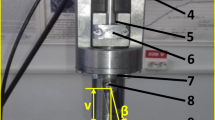Abstract
A new device was developed to assess fatigue life under biaxial tensile loading at elevated temperatures. It makes use of an annular disk specimen and can be easily mounted onto a standard push-pull machine so that the axial force is converted into radial forces extending across the disk specimen. Therefore, a positive ratio of the tangential to the radial stress can be imposed at the reduced section of the disk specimen; this ratio depends on the specimen configuration and may be fixed to a value ranging from 0.5 to 0.9 by varying the inner diameter of the disk. The proposed device has performed successfully and was used to study the cyclic behavior of Type-304 stainless steel subjected to various biaxial tensile stress states at room temperature and at 200°C. The data obtained from this experimental procedure have been analyzed to evaluate the effectiveness of some correlations already available for treating the biaxial cyclic stress-strain response in terms of the uniaxial behavior. This analysis shows that a successful correlation should account for all the stress components. The authors discuss the concept used in the modeling of the material cyclic behavior and the formulation of a biaxial fatigue damage parameter necessary for an effective analytical life prediction methodology.
Similar content being viewed by others
Abbreviations
- a :
-
characteristic radial length in the gage section of the disk specimen
- E :
-
elastic modulus
- F, F1, F2 :
-
axial loads
- K, K′ :
-
monotonic and cyclic strain-hardening coefficients
- M b :
-
bending moment
- M t :
-
torsion moment
- n, n′ :
-
monotonic and cyclic strain-hardening exponents
- P :
-
internal/external pressure
- R :
-
load ratio (ratio between the minimum and maximum applied load)
- R b :
-
disk bore radius
- (r, θ,z):
-
cylindrical coordinates
- T :
-
test temperature
- x :
-
radial distance from the center of the gage section
- ∈ eq :
-
von Mises equivalent strain
- ∈ r :
-
radial strain
- ∈ θ :
-
tangential strain
- ∈ z :
-
axial strain
- Υ eq :
-
Tresca equivalent strain or maximum shear strain
- ν:
-
Poisson's ratio
- ρ:
-
biaxial stress ratio (ρ= σ θ /σ r )
- σ1σ2 :
-
in-plane maximum and minimum principal stresses
- σ eq :
-
von Mises equivalent stress
- (σ Misses )max:
-
maximum von Mises stress in the specimen
- σ r :
-
radial stress
- σ rz ,σθz, σ xz :
-
shear stresses
- σθ :
-
tangential stress
- σ u :
-
ultimate tensile stress
- σ x ,σ z :
-
axial stress
- σ y :
-
yield stress
- τ eq :
-
Tresca equivalent stress or maximum shear stress
References
Zouani, A., Bui-Quoc, T., andBernard, M., “A Proposed Device for Biaxial-tensile Fatigue Testing,”Fatigue and Fracture-1996, ASME PVP-323,1,331–339 (1996).
Ellyin, F. and Wolodko, J.D., “Testing Facilities for Multiaxial Loading of Tubular Specimens,” Proceedings of the 1995 Symposium on Multiaxial Fatigue and Deformation Testing Techniques, SAE STP 1280, Denver, Colorado, 7–24 (1997).
Itoh, T., Sakane, M., Ohnami, M., andSocie, D., “Nonproportional Low-cycle Fatigue Criterion for Type-304 Stainless Steel,”ASME J. Eng. Mat. Tech.,117,285–292 (1995).
Brown, M.W. andMiller, K.J., “Biaxial Cyclic Deformation Behaviour of Steels,”Fatigue Eng. Mat. Struct.,1 (1),93–106 (1979).
Doquet, V. andPineau, M., “Multiaxial Low-cycle Fatigue Behaviour of Mild Steel,”Fatigue Under Biaxial and Multiaxial Loading, ESIS10, ed. K. Kussmaul, D. McDiarmid andD. Socie, Mechanical Engineering Publications, London, 81–101 (1991).
Nishino, S., Hamada, N., Sakane, M., Ohnami, M., Matsumara, N., andTokizane, M., “Microstructural Study of Cyclic Strain Hardening Behaviour in Biaxial Stress States at Elevated Temperature,”Fatigue Eng. Mat. Struct.,9,65–77 (1986).
Bonacuse, P.J. andKalluri, S., “Elevated Temperature Axial and Torsional Fatigue Behavior of Haynes 188,”ASME J. Eng. Mat. Tech.,117,191–199 (1995).
Zouani, A., Bui-Quoc, T., andBernard, M., “Optimal Design of a Disk-shaped Specimen for Biaxial-tensile Fatigue Testing,”ASTM J. Test. Eval.,24 (5),287–294 (1996).
Murakami, S., Kawai, M., andOhmi, Y., “Effects of Amplitude-history and Temperature-history on Multiaxial Cyclic Behavior of Type-316 Stainless Steel,”ASME J. Eng. Mat. Tech.,111,278–285 (1989).
Yoshida, F., “Uniaxial and Biaxial Creep-ratcheting Behavior of SUS 304 Stainless Steel at Room Temperature,”ASME Int. J. Pres. Ves. Piping,44,207–223 (1990).
Dowling, N.E., Mechanical Behavior of Materials, Prentice Hall, Englewood Cliffs, NJ, 536–540 (1993).
Author information
Authors and Affiliations
Rights and permissions
About this article
Cite this article
Zouani, A., Bui-Quoc, T. & Bernard, M. Cyclic stress-strain data analysis under biaxial tensile stress state. Experimental Mechanics 39, 92–102 (1999). https://doi.org/10.1007/BF02331111
Received:
Revised:
Issue Date:
DOI: https://doi.org/10.1007/BF02331111



